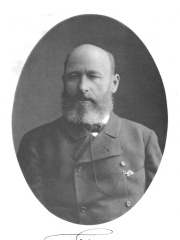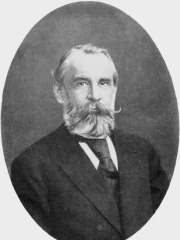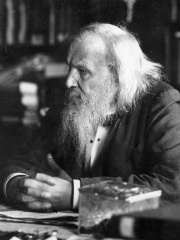
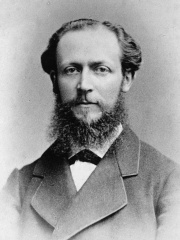
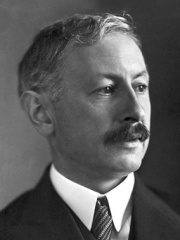
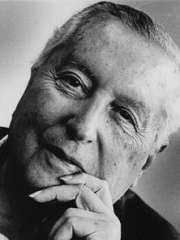
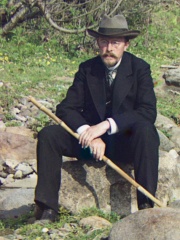
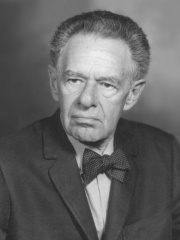
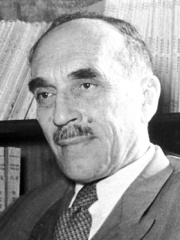
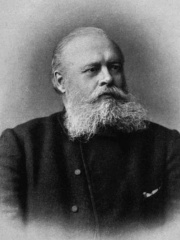
The Most Famous
CHEMISTS from Russia
Top 10
The following people are considered by Pantheon to be the top 10 most legendary Russian Chemists of all time. This list of famous Russian Chemists is sorted by HPI (Historical Popularity Index), a metric that aggregates information on a biography's online popularity. Visit the rankings page to view the entire list of Russian Chemists.

1. Dmitri Mendeleev (1834 - 1907)
With an HPI of 86.92, Dmitri Mendeleev is the most famous Russian Chemist. His biography has been translated into 154 different languages on wikipedia.
Dmitri Ivanovich Mendeleev ( MEN-dəl-AY-əf; 8 February [O.S. 27 January] 1834 – 2 February [O.S. 20 January] 1907) was a Russian chemist known for formulating the periodic law and creating a version of the periodic table of elements. He used the periodic law not only to correct the then-accepted properties of some known elements, such as the valence and atomic weight of uranium, but also to predict the properties of three elements that were yet to be discovered (germanium, gallium, and scandium).

2. Otto Wallach (1847 - 1931)
With an HPI of 78.30, Otto Wallach is the 2nd most famous Russian Chemist. His biography has been translated into 71 different languages.
Otto Wallach (German pronunciation: [ˈɔto ˈvalax] ; 27 March 1847 – 26 February 1931) was a German chemist and recipient of the 1910 Nobel Prize in Chemistry for his work on alicyclic compounds.

3. Paul Karrer (1889 - 1971)
With an HPI of 77.10, Paul Karrer is the 3rd most famous Russian Chemist. His biography has been translated into 64 different languages.
Paul Karrer (21 April 1889 – 18 June 1971) was a Swiss organic chemist best known for his research on vitamins. He and British chemist Norman Haworth won the Nobel Prize for Chemistry in 1937.

4. Ilya Prigogine (1917 - 2003)
With an HPI of 75.46, Ilya Prigogine is the 4th most famous Russian Chemist. His biography has been translated into 68 different languages.
Viscount Ilya Romanovich Prigogine (; Russian: Илья́ Рома́нович Приго́жин; 25 January [O.S. 12 January] 1917 – 28 May 2003) was a Belgian physical chemist of Russian-Jewish origin, noted for his work on dissipative structures, complex systems, and irreversibility. Prigogine's work most notably earned him the 1977 Nobel Prize in Chemistry “for his contributions to non-equilibrium thermodynamics, particularly the theory of dissipative structures”, as well as the Francqui Prize in 1955, and the Rumford Medal in 1976.
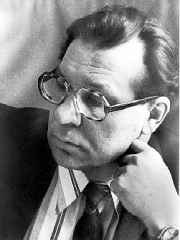
5. Valery Legasov (1936 - 1988)
With an HPI of 73.95, Valery Legasov is the 5th most famous Russian Chemist. His biography has been translated into 41 different languages.
Valery Alekseyevich Legasov (Russian: Валерий Алексеевич Легасов; 1 September 1936 – 27 April 1988) was a Soviet inorganic chemist and a member of the Academy of Sciences of the Soviet Union. He is primarily known for his efforts to contain the 1986 Chernobyl disaster. Legasov also presented the findings of an investigation to the International Atomic Energy Agency at the United Nations Office at Vienna, detailing the actions and circumstances that led to the explosion of Reactor No. 4 at the Chernobyl Nuclear Power Plant.

6. Sergey Prokudin-Gorsky (1863 - 1944)
With an HPI of 70.68, Sergey Prokudin-Gorsky is the 6th most famous Russian Chemist. His biography has been translated into 54 different languages.
Sergey Mikhaylovich Prokudin-Gorsky (Russian: Сергей Михайлович Прокудин-Горский, IPA: [sʲɪrˈɡʲej mʲɪˈxajləvʲɪtɕ prɐˈkudʲɪn ˈɡorskʲɪj] ; August 30 [O.S. August 18] 1863 – September 27, 1944) was a Russian chemist and photographer. He is best known for his pioneering work in colour photography and his effort to document early 20th-century Russia. Using a railway-car darkroom provided by Emperor Nicholas II, Prokudin-Gorsky travelled the Russian Empire from around 1909 to 1915 using his three-image colour photography to record its many aspects. While some of his negatives were lost, the majority ended up in the US Library of Congress after his death. Starting in 2000, the negatives were digitised and the colour triples for each subject digitally combined to produce hundreds of high-quality colour images of Russia and its neighbours from over a century ago.

7. Fritz Albert Lipmann (1899 - 1986)
With an HPI of 70.57, Fritz Albert Lipmann is the 7th most famous Russian Chemist. His biography has been translated into 53 different languages.
Fritz Albert Lipmann (German pronunciation: [fʁɪts ˈʔalbɛʁt ˈlɪpman] ; June 12, 1899 – July 24, 1986) was a German-American biochemist and a co-discoverer in 1945 of coenzyme A. For this, together with other research on coenzyme A, he was awarded the Nobel Prize in Physiology or Medicine in 1953 (shared with Hans Adolf Krebs).

8. Nikolay Semyonov (1896 - 1986)
With an HPI of 69.07, Nikolay Semyonov is the 8th most famous Russian Chemist. His biography has been translated into 63 different languages.
Nikolay Nikolayevich Semyonov , sometimes Semenov, Semionov or Semenoff (Russian: Никола́й Никола́евич Семёнов; 15 April [O.S. 3 April] 1896 – 25 September 1986) was a Soviet physicist and chemist. Semyonov was awarded the 1956 Nobel Prize in Chemistry for his work on the mechanism of chemical transformation.

9. Vladimir Markovnikov (1838 - 1904)
With an HPI of 67.41, Vladimir Markovnikov is the 9th most famous Russian Chemist. His biography has been translated into 37 different languages.
Vladimir Vasilyevich Markovnikov, also Markownikoff (Russian: Влади́мир Васи́льевич Марко́вников; 25 December [O.S. 13 December] 1837 – 11 February 1904) was a Russian chemist, best known for having developed the Markovnikov's rule, that describes addition reactions of hydrogen halides and alkenes.
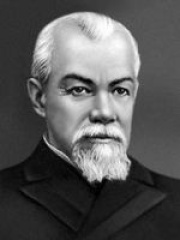
10. Alexander Mikhaylovich Zaytsev (1841 - 1910)
With an HPI of 65.68, Alexander Mikhaylovich Zaytsev is the 10th most famous Russian Chemist. His biography has been translated into 27 different languages.
Aleksander Mikhaylovich Zaytsev, also Zaitsev, Saytzeff, or Saytzev (Russian: Алекса́ндр Миха́йлович За́йцев; 2 July 1841 – 1 September 1910) was a Russian chemist. He worked on organic compounds and proposed Zaytsev's rule, which predicts the product composition of an elimination reaction.
People
Pantheon has 22 people classified as Russian chemists born between 1827 and 1938. Of these 22, none of them are still alive today. The most famous deceased Russian chemists include Dmitri Mendeleev, Otto Wallach, and Paul Karrer.
Deceased Russian Chemists
Go to all RankingsDmitri Mendeleev
1834 - 1907
HPI: 86.92
Otto Wallach
1847 - 1931
HPI: 78.30
Paul Karrer
1889 - 1971
HPI: 77.10
Ilya Prigogine
1917 - 2003
HPI: 75.46
Valery Legasov
1936 - 1988
HPI: 73.95
Sergey Prokudin-Gorsky
1863 - 1944
HPI: 70.68
Fritz Albert Lipmann
1899 - 1986
HPI: 70.57
Nikolay Semyonov
1896 - 1986
HPI: 69.07
Vladimir Markovnikov
1838 - 1904
HPI: 67.41
Alexander Mikhaylovich Zaytsev
1841 - 1910
HPI: 65.68
Alexander Butlerov
1828 - 1886
HPI: 64.53
Friedrich Konrad Beilstein
1838 - 1906
HPI: 61.93
Overlapping Lives
Which Chemists were alive at the same time? This visualization shows the lifespans of the 22 most globally memorable Chemists since 1700.

